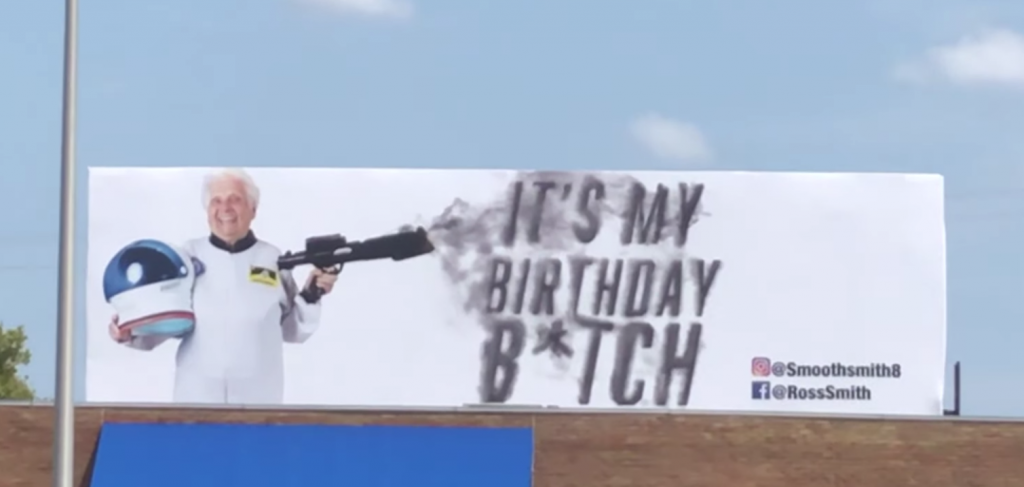What Can’t You Put On A Billboard?
Since my time working in the out-of-home industry was recently put to an end, I thought I’d answer one of the most common questions I’d get: what can’t you put on a billboard? The answer is almost as nebulous as the question itself. Let’s take a look at a billboard that was recently taken down.
This controversial billboard (pictured above) was recently taken down in Columbus, Ohio. It features an elderly woman in a spacesuit, holding a helmet in one hand and a gun in the other. The text on the billboards reads, “It’s my birthday, b*tch.”
It was purchased by social media and viral video star, Ross Smith. The woman on the billboard is Ross’s grandmother, who frequently appears in his videos. According to Ross, the billboard was supposed to be a birthday present for his grandma and its intent was to mock the “Storm Area 51” movement.
After the mass shootings in El Paso on Aug. 3rd and Dayton on Aug. 4th, the billboard company received several complaints about the billboard. It was removed immediately.
There are a lot of opinions about removing this billboard, both for and against. Many people can’t believe it ever went up in the first place. What actually is and isn’t allowed on a billboard, anyhow? Previously, buying a billboard meant you bought from an advertising expert, so knowing content regulations wasn’t necessary. Technology now allows anyone to buy a billboard online, so it’s more important for media buyers and marketers to understand the rules and regulations.
Believe it or not, federal billboard regulations have more to do with specifics of the actual billboard structures themselves. They control things such as billboard size, how billboards can be lit, where billboards can be placed, and so on. As far as content is concerned, the Supreme Court has consistently held that regulations limiting noncommercial protected speech violate the First Amendment.
While there are also state and local laws that can place additional regulations or restrictions on billboard content, by and large, the outdoor advertising industry is self-regulated. Though you might not see billboards for cigarettes anymore, they actually aren’t illegal. In 1999, all the major cigarette brands voluntarily signed an MSA agreeing not to use outdoor ads anymore. Another example of self-regulation is billboard companies agreeing not to place ads for items illegal to children in places where children frequent. This is why you won’t see ads for alcohol or e-cigarettes within 500 feet of a school, playground, or church.
Aside from these very general rules, it is up to the billboard companies themselves to decide what they put up. It’s commonplace to see social messages on billboards related to abortion, religion, or labor unions. Like any company, they want to take your money but they also don’t want to expose themselves to costly fines, drawn-out lawsuits, or just plain old bad publicity. Content that is very likely to upset people will give billboard companies pause. Some areas they tend to be sensitive to include extreme politics, overly sexual content or nudity, endorsement of illegal activities, curse words, and guns.
Keep in mind that while you do have your First Amendment right to free speech, you don’t have a right to place your message on a billboard. If your message is deemed too offensive, billboard companies are generally open to working with you to come up with something they are comfortable with posting. Just remember that like the Ross Smith billboard, when faced with public backlash, the company is likely to pull it. It’s in your own best interest to make your design and message as inoffensive as possible.
So, what can’t you put on a billboard? Well, it depends. ¯\_(ツ)_/¯

I LOVE THIS SO MUCH TANK YOU HAHAHAH